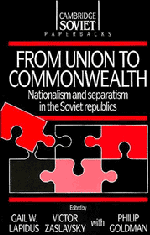Book contents
- Frontmatter
- Contents
- Notes on the contributors
- Preface
- Glossary
- Map: the Soviet Successor States
- 1 Introduction: Soviet federalism – its origins, evolution, and demise
- 2 State, civil society, and ethnic cultural consolidation in the USSR – roots of the national question
- 3 From democratization to disintegration: the impact of perestroika on the national question
- 4 The evolution of separatism in Soviet society under Gorbachev
- 5 Perestroika and the ethnic consciousness of Russians
- 6 Nationality policies in the period of perestroika: some comments from a political actor
- Index
4 - The evolution of separatism in Soviet society under Gorbachev
Published online by Cambridge University Press: 03 May 2011
- Frontmatter
- Contents
- Notes on the contributors
- Preface
- Glossary
- Map: the Soviet Successor States
- 1 Introduction: Soviet federalism – its origins, evolution, and demise
- 2 State, civil society, and ethnic cultural consolidation in the USSR – roots of the national question
- 3 From democratization to disintegration: the impact of perestroika on the national question
- 4 The evolution of separatism in Soviet society under Gorbachev
- 5 Perestroika and the ethnic consciousness of Russians
- 6 Nationality policies in the period of perestroika: some comments from a political actor
- Index
Summary
The nationality crisis in the Soviet Union has been the most acute manifestation of the general crisis of Soviet-type societies. Whereas the deepening economic crisis has undermined the superpower status of the Soviet Union, the nationality crisis was the main threat to the survival of the Soviet empire, which has finally entered into a period of disintegration after more than seven decades. To use a term no longer in vogue, the Soviet Union has provided us with yet another example of the dialectic of history, when the same social arrangements and policies that had served as the pillars of internal stability suddenly became counterproductive, leading to instability and profound tension.
The Soviet federal policy, based on the Stalinist definition of a nation that includes a national territory as the essential attribute, established an inseparable link between an ethnic group, its territory, and its political administration. The Soviet state successfully manipulated nationality relations by forging an administrative hierarchy of different levels of statehood which were assigned to various nationalities. A quota system was also organized which promoted the preferential treatment of indigenous nationalities within their delimited territories, regulated competition for university admissions, and restricted access to managerial and administrative jobs. Ethnic identity was transformed into an institutional reality by the mandatory registration of ethnic affiliation in internal passports.
- Type
- Chapter
- Information
- From Union to CommonwealthNationalism and Separatism in the Soviet Republics, pp. 71 - 97Publisher: Cambridge University PressPrint publication year: 1992
- 11
- Cited by



